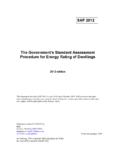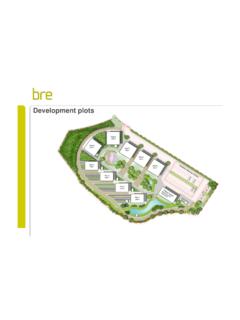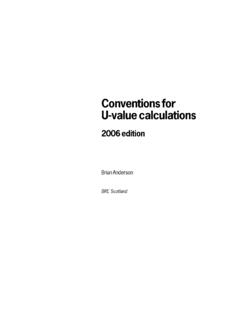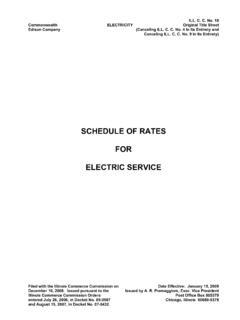Transcription of Planning guidance for the development of large scale ...
1 guidance for the development of large scale ground mounted solar PV systemsWith thanks to NSC Founding Partners BRE acknowledges the contribution of Cornwall Council towards the preparation of this guidance ; in particular through the provision of best practice advice and access to Council s solar energy Planning provide feedback on this Planning guidance please download the feedback form from (see Downloads menu).1 Planning guidance for the development of large scale ground mounted solar PV systemsContents1. Introduction / Foreword 32. Commercial scale ground mounted solar PV 5 Appendix A: guidance on the information which should be provided within a Landscape and Visual Impact Assessment 19 Appendix B: electricity Generating Capacity 22 Appendix C: EIA Screening Procedures Overview 232 Planning guidance for the development of large scale ground mounted solar PV systems3 Planning guidance for the development of large scale ground mounted solar PV systemsLondonDublinCardi BelfastEdinburghNewcastleBirminghamUK Solar irradiation mapYearly total of global irradition in kWh/m averaging period: 1997 - 2003722 - 800801 - 850851 - 900901 - 950951 - 10001001 - 10501051 - 11001101 - 11501151 - 12021.
2 Introduction / ForewordRising energy costs and the support of the Feed in Tariff (FiT) and the Renewable Obligations Certificates have significantly increased the financial viability and attractiveness of installing solar PV panels. These installations may be roof / wall mounted or standalone / ground national guidance provides best practice Planning guidance in respect of how large ground mounted arrays are developed setting out Planning considerations and the purposes of Planning stand-alone solar PV installations are those that are not physically attached to a building, although they can be wired to provide electricity to a building. This is a different meaning for the purpose of the FiT where as well as not beingphysically attached to a building they also must not be wired to provide electricity to an occupied building ie they are connected directly to the electricity Energy in the UKThe amount of energy that can be harnessed from the sun s radiation is often underestimated.
3 In the UK we receive a vast amount of solar energy, in an average year we receive as much as 60% of the solar energy which is received at the equator. This can be compared to the yearly output of 1,000 power map below shows the total average solar irradiation falling on a one square metre surface on the horizontal, measured in kilo-watt hours (kWh). This shows that the sun s rays falling on the ground range from > 1200 kWh / m2 in the south west of the UK to < 900 kWh / m2 in northern Energy Policy ContextAt the national level, there is a range of statutory and non-statutory policy drivers and initiatives which are relevant to the consideration of Planning applications for Solar Energy. The Climate Change Act 2008 commits the UK to an 80% reduction in greenhouse gases by 2050 and a 34% reduction by 2020 (based on 1990 levels).The UK Renewable Energy Roadmap provides a series of measures to meet the legally-binding target set in the Climate Change Act 2008.
4 The roadmap envisages that more than 30% of UK electricity should be generated from renewable sources. The Roadmap states that the government believes that solar PV has the potential to form a significant part of the renewable energy generation mix. The Roadmap further states that in November 2012 the UK had of installed solar PV capacity in operation and that analysis indicates that the market could bring forward a total of 7 20GW of solar PV by 1 UK Solar irradiation map. Yearly total of global irradiation in kWh/m2. Averaging period: 1997-2003. Map data courtesy of the Met Office 4 Planning guidance for the development of large scale ground mounted solar PV systemsNational Planning PolicyThe National Planning Policy Framework (NPPF) sets out the national Planning policy context for renewable energy. This framework supports a transition to a low carbon future in a changing climate and encourages the use of renewable NPPF states that to help increase the use and supply of renewable and low carbon energy, local Planning authorities should recognise the responsibility on all communities to contribute to energy generation from renewable or low carbon sources.
5 The National Planning Policy Framework requires local Planning authorities to have a positive strategy to promote renewable or low carbon NPPF paragraph 98 states that when determining Planning applications for renewable energy developments, local authorities should not require applicants for energy development to demonstrate the overall need for renewable or low carbon energy and also recognise that small- scale projects provide a valuable contribution to cutting greenhouse gas emissions and approve the application if its impacts are (or can be made) Financial ContextThe Feed in Tariff (FiT) provides a financial subsidy towards a number of renewable energy technologies, including solar panels. For Solar photovoltaics, the FiT applies for a period of 20 years. The Renewables Obligation has more recently been used as a financial subsidy for large scale solar panel installations.
6 The Renewables Obligation provides incentives for large - scale renewable electricity generation by making UK suppliers source a proportion of their electricity from eligible renewable sources. It is proposed that the electricity Market Reform will provide financial incentives for renewable energy from 2014 onwards. This document relates specifically to the Planning policy framework permitted development and fees regulations for England. However many of the Planning conisderations are similar for Wales, Scotland and Northern Ireland. The production of specific guidance for these areas is being guidance for the development of large scale ground mounted solar PV systems2. Commercial scale ground mounted solar PVGround Mounted Solar PV projects, over 50kWp, should ideally utilise previously developed land, brownfield land, contaminated land, industrial land or agricultural land preferably of classification 3b, 4, and 5 (avoiding the use of Best and Most Versatile cropland where possible).
7 Land selected should aim to avoid affecting the visual aspect of landscapes, maintain the natural beauty and should be predominantly flat, well screened by hedges, tree lines, etc and not cause undue impact to nearby domestic properties or / BackgroundLarge, centralised solar PV power systems, mostly at the multi-megawatt scale , have been built to supply power for local or regional electricity grids in a number of countries including Germany, Switzerland, Spain and Italy. More recently large solar PV installations have been erected in England and guide aims to provide Planning guidance in respect of large scale commercial ground-mounted solar PV with the Local Planning Authority and local community is encouraged at an early stage. The local community should be engaged, by the developer, at the pre-design, conceptual stage, ideally utilising a local exhibition / presentation where community views can be sought and Impact Assessment (EIA) large scale solar PV arrays are not expressly listed in Schedule 2 to the EIA Regulations 1999; such developments may or may not have a significant effect on the environment, positive or negative, depending on Screening As a starting point the proposal should be assessed against the selection criteria in Schedule 3 of the EIA Regulations.
8 In general, an EIA is likely to be needed for Schedule 2 developments if the solar PV development is in a particularly environmentally sensitive or vulnerable location. In each case it will be necessary to judge whether the likely effects on the environment of that development will be significant in that particular location. In judging whether the effects of a development are likely to be significant it is necessary to have regard in particular to the visual impact of the development on landscape character and how this will be affected by the installation of a solar PV farm development , and also the possible cumulative effect with any existing or approved development . This should include situations where there is more than one application for solar PV development which should be considered together. Any views expressed by consultees should be taken into account.
9 Advice should be sought from consultees where there is any doubt about the significance of a development s likely effects on a sensitive area as defined in the EIA Performance AgreementsIn order to allow the Local Planning Authority to apply sufficient resources to meet the demand, applicants may wish to engage in a Planning Performance Agreement (PPA) with the Local Planning Authority. The PPA requires developers to make a financial contribution to the Authority who, in return, will utilise these funds to dedicate staff resources towards the Planning proposal put forward by the developer. The PPA requires the Authority to engage with the developer at the pre-application stage, assist with public consultation / engagement and engage with the developer throughout the Planning application requirementsPlanning Application FeeThe Local Planning Authority will be able to assist and confirm the level of information necessary to accompany and support any Planning application.
10 Should an Environmental Impact Assessment be considered necessary, there may be further requirements that will be determined through a scoping assessment in consultation with the Local Planning likely to be required includes - A location plan (1:1250 metric scale ) A site/block plan (1:500 metric scale ) Elevations Design and access statement A supporting statement Fencing specification and details (where applicable) Details of connection to electrical grid Details of any ancillary works or buildings proposed, including elevations An ecological assessment where applicable A landscape/visual assessment if the application site lies within, or would impact upon, an Area of Outstanding Natural Beauty; National Park or World Heritage Site (see Appendix A). A historic environment statement where applicable (see above). Impact assessment on agricultural land where applicable.
















![Electricity Regulation Act [No. 4 of 2006]](/cache/preview/6/a/5/5/a/0/d/5/thumb-6a55a0d556b9c34cf91d66ae31989ed3.jpg)